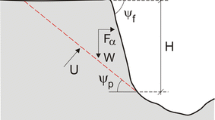Abstract
Given the lack of suitable systems in the characterization of slope stability of heavily jointed rock masses, a new rock mass classification system called Slope Stability Rating (SSR) is proposed. In addition to the so-called modified Geological Strength Index, the proposed system considers five additional parameters whose relative effects on the stability of fractured rock slopes were precisely examined based on data retrieved from eight different rock slope sites in Iran. An overall rating for the rock mass is obtained from the summation of the individual ratings of each parameter. A number of design charts are provided as illustration. The new system was then validated based on 46 slope case histories from Iran and Australia. For this, by means of the design charts previously mentioned, a recommended stable angle for each slope was given and compared with the current slope conditions. As a result, SSR design charts for maximum excavation angle (FS = 1.0) and also for other more conservative excavation angles (FS = 1.2, 1.3, 1.5) were presented.












Similar content being viewed by others
References
Barton NR, Lien R, Lunde J (1974) Engineering classification of rock masses for the design of tunnel support. Rock Mech 6(4):189–236
Bieniawski ZT (1973) Engineering classification of jointed rock masses. Trans S Afr Inst Civ Eng 15:335–344
Bieniawski ZT (1989) Engineering rock mass classification. Wiley, Chichester
Douglas KJ (2002) The shear strength of rock masses. Ph.D. Thesis, University of New South Wales, Australia
Douglas KJ, Mostyn G (1999) Strength of large rock masses—field verification. Rock Mechanics for Industry, Balkema, pp 271–275
Haines A, Terbrugge PJ (1991) Preliminary estimation of rock slope stability using rock mass classification systems. In: 7th International Congress on Rock Mechanics Proceedings ISRM, Aachen, vol 2, pp 887–892
Hoek E, Brown ET (1997) Practical estimates of rock mass strength. Int J Rock Mech Min Sci 3(8):1165–1186
Hoek E, Carranza-Torres CT, Corkum B (2002) Hoek–Brown failure criterion-2002 edition. In: Fifth North American rock mechanics sym. proc., vol 1, pp 267–273
Hunger Geotechnical Research Inc (1988) CLARA user’s manual
Marinos P, Hoek E (2000) A geologically friendly tool for rock mass strength estimation. In: International conference on geotechnical and geological engineering (GeoEng2000) proceedings, pp 1422–1440
Palmstrom A (1996) Characterizing rock masses by the Rmi for use in practical rock engineering, part 1. Tunnelling and underground. Space Technol 11(2):175–188
Ramamurthy T, Arora VK (1992) Strength and modulus for classification of jointed rocks. In: Regional symposium on rock slopes, India
Riedmuller G, Schubert W (1999) Rock mass modeling in tunneling versus rock mass classification using rating methods. Rock Mechanics for Industry, Balkema
Romana R (1993) A geomechanical classification for slopes: slope mass rating. Comprehensive rock engineering, John A. Hudson, Editor-in-Chief, pp 575–600
Rzhevsky V, Novik G (1967) The physics of rock. Russian edition
Singh B, Goel RK (1999) Rock mass classification. Elsevier, Amsterdam
Sonmez H, Ulusay R (1999) Modification to the geological strength index (GSI) and their applicability to stability of slopes. Int J Rock Mech Min Sci 36:743–760
Sonmez H, Ulusay R (2002) A discussion on the Hoek–Brown failure criterion and suggested modification to the criterion verified by slope stability case studies. Yerbilimleri (Earthsciences) 26:77–99
Sonmez H, Gokceoglu C, Ulusay R (2003) An application of fuzzy sets to the geological strength index (GSI) system used in rock engineering. Eng Appl Artif Intell 16:251–269
Sonmez H, Gokceoglu C, Ulusay R (2004) Indirect determination of the modulus of deformation of rock masses based on the GSI system. Int J Rock Mech Min Sci 41:849–857
Terzaghi K (1946) Rock defects and loads on tunnel support. In: Proctor RV, White TL (eds) Rock tunneling with steel supports, vol 1. Commercial Shearing and Stamping Company, Youngtown, pp 17–99
Acknowledgments
The authors wish to thank Dr. Antoine Duttine for reading the paper and his helpful suggestions to improve the manuscript.
Author information
Authors and Affiliations
Corresponding author
Rights and permissions
About this article
Cite this article
Taheri, A., Tani, K. Assessment of the Stability of Rock Slopes by the Slope Stability Rating Classification System. Rock Mech Rock Eng 43, 321–333 (2010). https://doi.org/10.1007/s00603-009-0050-4
Received:
Accepted:
Published:
Issue Date:
DOI: https://doi.org/10.1007/s00603-009-0050-4




